Properties of light in physics
What is light?
Light is a form of energy which is given by luminous objects. The Sun, bulb, candle, etc. are luminous objects. Other objects which do not give out light are called non-luminous objects. Light can pass through transparent materials. Glass, water, clear plastic and air are transparent materials. Light can not pass through translucent materials. Tracing paper, frosted glass and waxed paper are translucent materials.
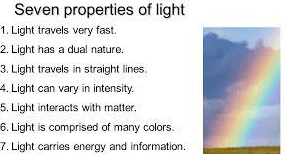 7 Properties of light
7 Properties of light
There are seven properties of light :
- Reflection of light
- Refraction of light
- Diffraction of light
- Interference of light
- Polarization of light
- Dispersion of light
- Scattering of light
Light behaves differently when it falls on different objects. When light falls on the surface of a non-luminous object, it can behave in three ways: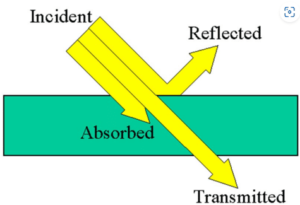
- When light falls on transparent objects, it is transmitted to the other side. That is why we can see across transparent objects.
- When light falls on rough opaque objects, most part of this light is absorbed and changed into heat energy. A black surface absorbs most of the light.
- When light falls on a smooth shiny surface, it bounces off in one particular direction. This bouncing off of light is called reflection of light.
Light travels in a straight line:
In a homogeneous isotropic medium light rays always travel in straight lines. Technically this is called rectilinear propagation of light. A pinhole camera is the best example of this rule. A simple pinhole camera consists of three parts; a photographic film, a pinhole aperture sheet and an object.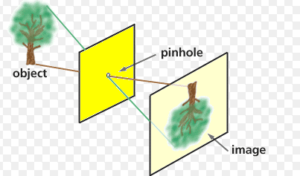
In this simple device, the image formation of a stationary object is formed on a photographic film or a white paper sheet. Those light rays that pass through the hole form the image of the object. In the figure, such two rays emerge from the object and pass through the hole and form an image of the object, the image formed by this device is inverted. The image size is directly proportional to the separation between the pinhole screen and the photographic screen. For a sharp image formation, the size of the pinhole must be much less than the size of the object, otherwise, blur image will be formed. This figure shows that light travels in straight lines.
See Also: interference of light
what is Dispersion of light?
“The splitting of white light into its component colours is called dispersion of light.”Sunlight is often called white light, although it is a combination of different colours. We can see these colours in a rainbow. These colours are red, orange, yellow, green, blue, indigo and violet.
We can split white light into its colours by passing it through the prism. The band of seven colours obtained is called the spectrum of white light.
Why does white light get dispersed?
When a beam of white light enters a prism, all the colours of white light refract at different angles. It causes the white light to split into its component colours. Red light bends the least. Violet light bends the most and refracts by the largest angle. In this way, white light disperses into its component colours.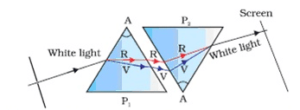
When this spectrum is again passed through another prism as shown in the figure, a beam of white light is obtained.
How is rainbow formed?
“A rainbow forms when sunlight is refracted and totally reflected by tiny water droplets.”
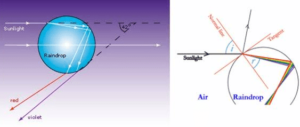 A rainbow is a natural demonstration of refraction, dispersion and total internal reflection of light. When the white light of the sun passes through tiny raindrops suspended after rainfall, a rainbow may appear. Raindrops in the air act like tiny prisms. They refract and reflect the sunlight and then separate it into different colours. The colour scheme of the rainbow is the same as in the spectrum made by the prism. Since the red colour bends the least and the violet colour bends the most from its original path, in the rainbow, the red colour appears at the top and the violet colour appears at the bottom. The other colours appear in between these two colours.
A rainbow is a natural demonstration of refraction, dispersion and total internal reflection of light. When the white light of the sun passes through tiny raindrops suspended after rainfall, a rainbow may appear. Raindrops in the air act like tiny prisms. They refract and reflect the sunlight and then separate it into different colours. The colour scheme of the rainbow is the same as in the spectrum made by the prism. Since the red colour bends the least and the violet colour bends the most from its original path, in the rainbow, the red colour appears at the top and the violet colour appears at the bottom. The other colours appear in between these two colours.
Colours of light: Primary and Secondary colours
An understanding of colours is very useful in photography and theatre lighting. People who work with lights of different colours must know how to produce lights of various colours from a few basic colours. The colours that can be used to make any other colour are called primary colours to produce white light.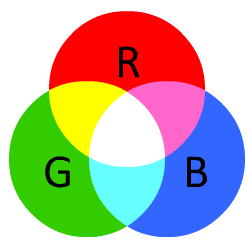
Red + Blue +Green =White
When two primary colours mix, they produce a secondary colour. Cyan, yellow and magenta are secondary colours. A colour television uses different combinations of colours.
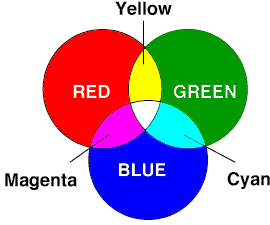
Red + Green = Yellow
Red + Blue =Cyan
Blue + Green =Magenta
We can obtain other colours of light by mixing lights of primary and secondary colours.
Colours of objects
When white light shines on non-luminous objects they reflect some colours and absorb all others. The colour of an object is the colour of the light it reflects. A red object appears red because it reflects the red colour of light and absorbs all the other colours. The grass of our lawn appears green as it reflects green light into our eyes. Why does a black car appear black?
When all the colours of light are reflected in our eyes, the object appears white. And, when all the colours of light are absorbed by the object, it appears black. Black objects do not reflect any light. Objects of colours reflect a mixture of colours.
Watch also:
See also:
Reflection of light
Refraction of light
wassssssupppppppppppp #im backkkkk
This article incorrectly states that “..light can not pass through translucent materials.”
This has really helped me with my homework. Thank you!